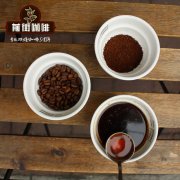The development trend of coffee in Ethiopia has changed from cooperative model to single boutique small-scale farmers.

Ethiopia Yega Xuefei producing area has become so famous that even Xiao 7's coffee has begun to use it. The details should not be introduced by the editor. However, there is a new trend in the Yega Sheffield system, that is, the development of a single small farmer and a single agricultural product. Let's share this new trend in Ethiopia with the new direction of the Waka Cooperative.
The editor first heard about this new development direction from the cup testing activities of the domestic raw bean trader Pebble Coffee and heard the lecture shared by the person in charge James before he began to inquire about the relevant information.
According to the Ethiopian decree, there are three types of coffee export systems:
(I) Private processing plants for export through ECX bidding
(II) Cooperative system
(3) single Manor system (Single Farm Project, SFP)
At present, most of these three export modes are still in the form of ECX transactions, and a few of them are through cooperatives or processing farms as direct trade, and single farms were hardly seen on the market three or four years ago.
However, after coming into contact with Berish farmers in the Waka Cooperative, we have seen the development of more and more single farms in the Yega and Guji producing areas.
In fact, the cooperative system is not bad, especially the internationally famous cooperatives such as Worka Cooperative, which produce mostly good beans.
The Waka Cooperative, founded in 2005, is located in a more remote part of the legal production area of Yega Snow Coffee, about 75 kilometers from the local coffee distribution center Dilla, while more than half of the coffee grown in Ethiopia belongs to the Garden Coffee type, that is, coffee is grown in a small area in its own backyard.
The Waka Cooperative is made up of 305 farmers, with a total planting area of about 763 hectares and an annual output of nearly 460 tons. The scale is not too large, but the members of the cooperative have strong cohesion and good quality, so they are often good goods, and even collectively apply for organic certification, but in the final analysis, the coffee cherries handled by the cooperative still come from a large number of small farmers, and the product curriculum vitae can not be traced back to a single producer. Therefore, such a so-called traceable source is accompanied by a vague dilemma, and the occasional occurrence of rat shit will destroy the trust of the co-operative. This continuous extension of traceability has also led to the launch of a single smallholder batch by the Waka Cooperative.
In fact, the single farm system (Single Farm Project, referred to as SFP) has always existed in Ethiopia, but its proportion is not high. In addition, in the past, there were a large number of commercial batches that did not attach importance to quality, so the type of single farm has not been favored by various farm owners, so the proportion of development cannot be increased for a long time.
However, with the third wave of boutique coffee in the past 20 or 30 years, Ethiopian coffee has emerged in the market, coupled with the fact that in the past, some strong Ethiopian coffee operators in Europe and the United States began to return to Ethiopia to operate coffee (ECX chairman is the United States scaa). This craze has also sowed the seeds of influence in the country of clothing after being baptized by the culture of the western coffee market, and has also brought new changes to the industry. According to the account of the coffee hunter, many local farmers have devoted themselves to the management of a single farm, and recently they have even led to an upsurge of returning from Europe and the United States to their hometown. Ethiopian coffee beans will be more interesting!
Important Notice :
前街咖啡 FrontStreet Coffee has moved to new addredd:
FrontStreet Coffee Address: 315,Donghua East Road,GuangZhou
Tel:020 38364473
- Prev

Why Miami Coffee Culture is influenced by Cuba introduction to Miami's unique coffee culture
Miami's coffee culture is inseparable from the influence of Latinos. More than 60 years of Cuban immigration history, unlike most major cities in the United States, has helped to create a culture in a way that enjoys coffee. This means that if you are a roaster or coffee shop that wants to enter this market, you should understand the way people's attitudes towards drinks are shaped. Cuba's contribution to Miami coffee culture
- Next

Is Congolese coffee a boutique coffee? What are the main varieties of coffee grown in Congo?
The Democratic Republic of the Congo (DRC) is rich in resources but lacks stability and infrastructure due to years of civil war. The country once had a booming coffee industry, but now needs to develop development strategies to help producers realize their great potential and improve the quality of life of farmers. But some non-governmental organizations and other agencies are taking steps to revitalize the coffee industry in the Democratic Republic of the Congo
Related
- Beginners will see the "Coffee pull flower" guide!
- What is the difference between ice blog purified milk and ordinary milk coffee?
- Why is the Philippines the largest producer of crops in Liberia?
- For coffee extraction, should the fine powder be retained?
- How does extracted espresso fill pressed powder? How much strength does it take to press the powder?
- How to make jasmine cold extract coffee? Is the jasmine + latte good?
- Will this little toy really make the coffee taste better? How does Lily Drip affect coffee extraction?
- Will the action of slapping the filter cup also affect coffee extraction?
- What's the difference between powder-to-water ratio and powder-to-liquid ratio?
- What is the Ethiopian local species? What does it have to do with Heirloom native species?

